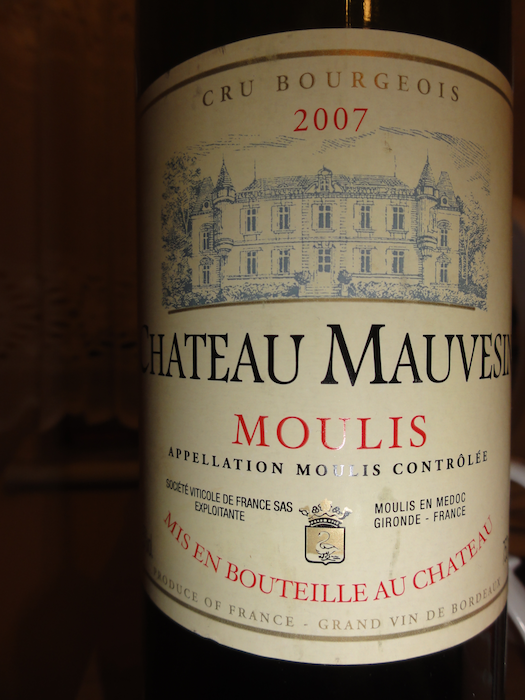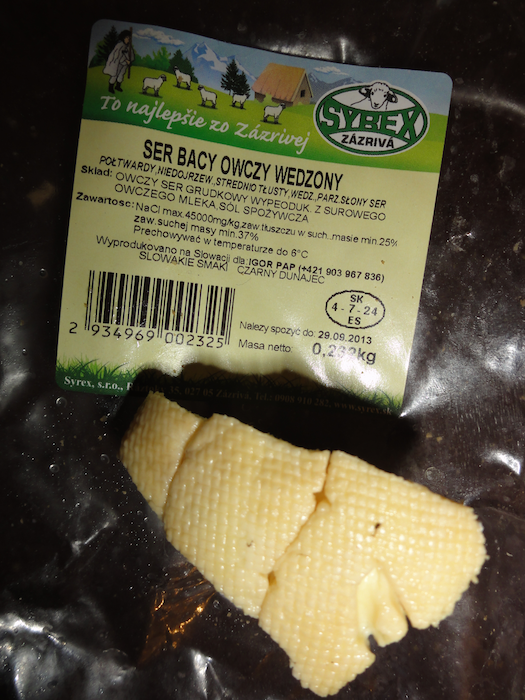Cru Bourgeois Chateau Mauvesin 2007
Moulis en Medoc AOC
Francja
Cabernet Sauvignon
Merlot
Cabernet Franc
Petit Verdot
Carmenere
Cena: 40
Alk: 12,50%
Kolor: cz
Nr 14683
www
Legenda (ocena):
     8 - wybitnie, prawdziwe arcydzieło
8 - wybitnie, prawdziwe arcydzieło
    7 - bardzo dobre, wino z dużą klasą
7 - bardzo dobre, wino z dużą klasą
   6 - dobre, interesujące
6 - dobre, interesujące
  5 - całkiem niezłe, przyzwoite
5 - całkiem niezłe, przyzwoite
 4 - słabe
4 - słabe
Brak gwiazdki
3 - omijać z daleka, wino z wyraźnymi wadami
| 
Inne od Chateau Mauvesin:
| star (2013-08-30)    Ocena: 6 Ocena: 6
Chasse Splean http://www.sstarwines.pl/rejon_Moulis ani Poujeaux to może nie jest, ale daje wszystko to czego spodziewałem się do Moulis ze średniej półki w lekkim roczniku, wcześniej nadającym się do picia. Aromatycznie bardziej skóra niż owoc, ale może się otworzy. Smakowo lekko, kwasowo i z polotem, pije się nader przyjemnie, bardzo dobra równowaga. Zwyczajnie smaczne. Mógłbym powtórzyć. Poziom alkoholu jak za starych, dobrych czasów. Wine Spectator pisał o tym http://www.winespectator.com/webfeature/show/id/45753 jak Bartonowie (Anthony i jego córka Lilian Barton Sartorius) kupili tą posiadłość ostatnio, w 2011 roku, więc styl może się zmienić. Zwracam uwagę na kilka rzędów Carmenere, ale z czego robią to wino to nie wiem, więc wpisuję jak leci. Newsweek.pl też odnotował http://www.newsweek.pl/przewodnikpowinach/chateau-mauvesin,98617,1,1.html je w sowim przewodniku. Szorstkie ponoć, sic!
The Barton family, owners of Bordeaux's Châteaus Langoa Barton and Léoville Barton, have made their first acquisition since the 1820s. Anthony Barton and his daughter Lilian Barton Sartorius have purchased Château Mauvesin, an estate in Moulis en Médoc. The price was undisclosed.
"We've been looking for four or five years," Barton Sartorius told Wine Spectator. "This château has been on the market for a while and the price was finally right."
The estate has been owned by the same aristocratic family since the 15th century, with the château built in 1853 by the last Marquis de Mauvesin. The sellers are the current generation—Alain de Baritault du Carpia and his wife, Helene Capbern-Gasqueton. Helene also operates Châteaus Calon-Ségur, a St.-Estèphe third-growth, and Capbern-Gasqueton, a cru bourgeois.
The 500-acre estate includes 120 acres of vines, most of which are classified as Moulis en Médoc, with some in the Haut-Médoc appellation. The terroir is a mix of clay and limestone on gentle slopes planted to Merlot, Cabernet Sauvignon, Cabernet Franc, Petit Verdot and a few rows of Carmenère. The vines average 35 years of age, but Barton Sartorius said they need work.
With the ink barely dry on the ownership papers, the Bartons took control for the 2011 harvest. The technical team from Langoa and Léoville, consultant Eric Boissenot and cellarmaster François Brehant, joined the Bartons and the onsite staff to make rapid changes that would improve quality. The extensive cellars underwent a quick temporary renovation. They installed 22 new, squat stainless-steel vats in various sizes, allowing increased precision during vinification and blending.
For the harvest, the team brought in a new tractor that offloads the grapes by vibration, a vibrating sorting table, and an optical sorter—a rare sight in Moulis—all of which helped bring in consistent crop after the challenging 2011 growing season.
"Next year, we start all over again. The vat room will become the cellar room and we're building an underground vat room so we can work with gravity," explained Barton Sartorius. "We considered cement vats, but they would not have been mobile."
For Barton Sartorius, the property is about family. She plans to live in the château with her husband, Michel Sartorious, who works with her and her father in the family's négociant business.
And they have two children, both young adults studying to work in the wine industry. Daughter Melanie has completed studies in agriculture and enology in Burgundy and Bordeaux. She will be the first enologist in the Barton family, and plans to return to the family châteaus after a two-year stint at a Tuscan winery that belongs to Eric Albada Jelgersma, owner of Château Giscours. "She'll be back in time for the bottling of the 2011 vintage in 2013," said Barton Sartorious. Their son Damien also put in two years in agriculture school and is currently in business school.
While a label design for the new property has not yet been selected, "the Chinese decided the name for me," said Barton Sartorius. An enterprising individual in China copyrighted the name Château Mauvesin. Rather than engage in a legal battle or buy back the name, the Bartons will call their new wine Château Mauvesin Barton. @Lidl
star (2013-08-30)
Notka z Newsweeka, fotka z Karwi, ser z Zazrivy;-)
Wino czerwone, wytrawne, średnio ciężkie. Oficjalnie zaliczone do klasyfikacji jakościowej Cru Bourgeois.
Rocznik: 2007
Region i klasa jakości: Appellation Moulis Contrôlée
Zawartość alkoholu: 12,5%
Opis: Wino klarowne w kolorze średnio intensywne, malinowo-buraczane z delikatnymi pomarańczowymi refleksami. Zapach przyjemnie aromatyczny, słodki, owocowo-spożywczy. Wyczuwalne są nuty przetworzonych owoców – śliwek, wiśni, czarnej porzeczki oraz wanilii i lukrecji. Po pewnej chwili w kieliszku pojawiają się aromaty przemysłowe – aceton i guma. W ustach silnie zaakcentowana jest kwasowość i garbnik. Dość szorstkie i zdecydowane właściwości ściągające zdają się dominować. Skojarzenia smakowe kierują się w stronę wiśni, przez czerwoną porzeczkę po gorzką czekoladę.
wino14683#48467  star (2013-08-30)
Bardziej pasuje mi notka z 2009 rocznika, z CThttp://www.cellartracker.com/wine.asp?iWine=1073710 średnia 87PP, tak leci i zero Carmenere!
This powerful, smoky, and totally sexy wine is comprised of 45% Cabernet Sauvignon, 40% Merlot, 10% Cabernet Franc, and 5% Petit Verdot. This stylish wine delivers aroma and flavors of dark cherry with spicy French Oak. Silky and sleek texture, integrated tannins and the long layered finish put on a beautiful show.
It paired beautifully with squab and stuffing – the strong tannic structure complementing the gamey meat of the squab and cutting through through the fattiness of the stuffing, keeping it from coating the mouth.
wino14683#48468 star (2013-08-30)
Nie wiem kto pisze dla Newsweeka przewodnik po winach (pralinka) ale wygląda na to jakby Lidl ich zalał swoimi winami, chyba się nie mylę?
wino14683#48469 star (2013-08-30)   Ocena: 5 Ocena: 5
Może moja butelka szybciej wyewoluowała? Drugiego dnia nieco zgasła już, więc może blisko być fazy passe, czyli pić już dziś nie czekać.
wino14683#48471 star (2013-08-31)
Zdecydowanie dojrzałe, a nawet przejrzałe (słodkie, miodowe, śliwkowe) sądząc po tym jak szybko z dnia na dzień schodzi. Żałuję, że nie wypiłem całej butelki pierwszego dnia, sic!
wino14683#48490 star (2013-09-01)
169KC u naszych sąsiadów (pralinka) i widać, że mi się dojrzalsza flaszka trafiła, bo oni też każą jeszcze trzymać.1. Château Mauvesin Cru Bourgeois 2007 Appellation Moulis Contrôlée (AOC) - Château Mauvesin, Francie
Cena 169,- Kč (0,75 L), alkohol 12,5 % obj. Hrozny mají původ ve vinařské podoblasti Moulis (též Moulis-en-Médoc) v Bordeaux. V případě vinařské podoblasti Moulis, přebírám následující text z encyklopedie p.j.: Menší oblast z jihu přiléhající k Listracu, nedaleko Margaux, ale stejně jako Listrac nesahá až k řece. Lesy prý poskytují ideální prostředí milovníkům honů. Půda je smíšená, štěrkovito-vápenitá. Vína jsou silnější než blízké Margaux, nepostrádají individualitu, bohaté aroma ani komplexní chuť. Doporučují se k jehněčímu, hovězímu i drůbeži. Otevírat nejdříve pátým rokem po sklizni.
Takže tedy otevírám, máme pátý rok po sklizni :-) Adjustáž je podle mne velmi zdařilá, byť nijak zásadně nevybočuje ze zavedeného klišé. Plný a velmi kvalitní korek délky 45 mm s potiskem vinařství a Cru Bourgeois, což je znamená víno dobré až vynikající kvality a představuje asi třetinu vín v Médocu. Jsou často řazena do malých Château. Barva je višňově červená, má slušnou intenzitu a rubínové záblesky. Vůně je hluboká a už od prvního okamžiku naznačuje, že půjde o hutnější a zajímavé víno. Jsou zde zvláštní ovocité tóny, které připomínají višně a brusinky. Vše se přesouvá do dřeva a jemných skořicových odstínů. Druhý den vystoupí nádherná griotka a hořká čokoláda. Chuť je středně dlouhá, plná a docela nabušená. Třísloviny potřebují ještě čas, aby se zakulatily a dotvořily se do ještě lepší harmonie. Archivační potenciál uvádí Lidl až 10 let a vůbec bych se nebál lahev otevřít nejdříve v roce 2015. Víno můžete podávat k sušené šunce, klobásám nebo tvrdým sýrům při teplotě 18 °C. Je to zajímavé víno, které jsem si koupil znovu a ukládám do archivu na několik let.
wino14683#48492 star (2014-04-09)
Boissenot - już po drugiej fermentacji zaczyna proces doboru poszczególnych win, gdy Rolland blend tworzy jak najpóźniej. Derenoncourt z kolei - do degustacji en primeur przyspiesza różnymi metodami dojrzewania wina z próbek. Boissenot wierzy w kupaż - mono cab z jednej parceli nie da dobrego wina. Markowi Bieńczykowi, Ducru Beaucaillou wydało się ok, ale nie porwało. Ponsot 2004 - burgund z miernego rocznika zachwycił. Haut Brion z 2010 za 1200E za butelkę, białe! O 2010 nic nie da się powiedzieć, pewno będą dobre i tyle, za lat ileś tam. Grand Puy Ducasse 1998, jedne z najgorszych grand cru classe, wyciruch sueprmarketów, z kiepskiego rocznika, pyszne! A jak przy supermarketach jesteśmy to Wein-r zapewnia, że Pedesclaux 2009 niezłe, ale nudne, dobrze zrobione nawet. Natomiast Camensac 2009, absolutnie nie do picia, przynajmniej teraz i z przyjemności(ą)... póki co nici. Surowa forma.
wino14683#50142 |
 ,
Mobile
Przed Swietami
na święta
szampan na sylwestra
Najlepszy szampan
SstarChat
Ostary 2009
Dwa lata
World Cup
Gambero Rosso w Warszawie
wino na święta,
wino na Wielkanoc,
wino na Wielkanocny czas,
Wino na Walentynki
Bożo w porzo?
wino na sylwestra,
wina kobiet,
wina slodkie,
idzie wiosna - róż
wina różowe
wina musujace,
inne alkohole,
wino na wesele,
wino z kartonu,
(nie)winna pocztówka z wakacji,
pocztówka z przedostatnich wakacji,
pocztowka z ostatnich wakacji,
cztery pory roku,
wino na lato
marzenia i plany
inwestycje
oceny
wina na bankiet,
tanie i dobre wino,
biodynamika,
filoksera,
terroir,
odwrócona osmoza
kora,
sztuka,
muzyka,
literatura,
kryzys,
zagadki,
winne ciekawostki,
dziwne flaszki,
komiksowina,
manifa,
znaki zodiaku,
enomasaż i winoterapia
dziennikarstwo i tannat
teatrum vinum profanum
fakty i mity
enolingua
kradzież wina
bożole nuwo niejedno ma imię
wzorzec chianti,
filmowo, a jak nie wiesz - zapytaj!
grand prix mw na mecie
Tour de France
Tour de Pologne
Siatka
Swim in Buda
Barca na lekko
,
Mobile
Przed Swietami
na święta
szampan na sylwestra
Najlepszy szampan
SstarChat
Ostary 2009
Dwa lata
World Cup
Gambero Rosso w Warszawie
wino na święta,
wino na Wielkanoc,
wino na Wielkanocny czas,
Wino na Walentynki
Bożo w porzo?
wino na sylwestra,
wina kobiet,
wina slodkie,
idzie wiosna - róż
wina różowe
wina musujace,
inne alkohole,
wino na wesele,
wino z kartonu,
(nie)winna pocztówka z wakacji,
pocztówka z przedostatnich wakacji,
pocztowka z ostatnich wakacji,
cztery pory roku,
wino na lato
marzenia i plany
inwestycje
oceny
wina na bankiet,
tanie i dobre wino,
biodynamika,
filoksera,
terroir,
odwrócona osmoza
kora,
sztuka,
muzyka,
literatura,
kryzys,
zagadki,
winne ciekawostki,
dziwne flaszki,
komiksowina,
manifa,
znaki zodiaku,
enomasaż i winoterapia
dziennikarstwo i tannat
teatrum vinum profanum
fakty i mity
enolingua
kradzież wina
bożole nuwo niejedno ma imię
wzorzec chianti,
filmowo, a jak nie wiesz - zapytaj!
grand prix mw na mecie
Tour de France
Tour de Pologne
Siatka
Swim in Buda
Barca na lekko